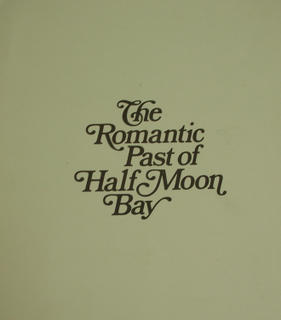
In an earlier post, I told you that the circa 1970s Half Moon Bay developers Deane and Deane (along with big corporaton partner Westinghouse) sought to personalize the Coastside, you know, give it a personality, stamp it with an identity. So they started the popular highway-clogging Pumpkin Festivalâin its own way similar to the Ocean Shore Railroadâs tactic of giving potential lot buyers a free ride to the Coastsideâs gorgeous isolated and never-seen-before beaches where some hack gave the captive audience a free lunch and a real estate pitch).
But there was more. In the 1970s the developers published a classy looking pamphlet on 100% recycled paper called
The Romantic Past of HalfMoon Bay
Half Moon Bay is San Mateo Countyâs oldest town. The first dwellers were, of course, the native Indians; the large shell mound at Pillar Point was their old village of Shagunte. Some people think the Indians of Shagunte greeted Sir Francis Drake when he landed along the coast in 1579. There is some evidence that it was Half Moon Bay where the old sea-dog anchored for repairs after raiding Spanish settlements in Mexico and South America. First use dsof the territory was made by the Mission Dfolores, as pasture land for their livestock.
But real immigration did not begin until 1846, when the land-grant holders were driven out by the invaders during the Mexican-American war. At that time there were only seven houses, built with adobe by Indian labor. Of these, five may still be identified. In fact, the streets of Half Moon Bay today run in the directions determined by the location of those old adobe homes. But even in the â49er Gold Rush days the town boasted little more than seventy people. By 1852, the population had increased by only fifteen people.
In 1853, things changed. The territory became a town and, by 1855, had its own schoolâand its own saloon. The first pier was built in 1858 near Pillar Point. The first âhighwayâ? to San Francisco opened in 1854, a wagon trail that replaced the almost impassable paths. Then a big flour millcame to town in 1860âand Half Moon Bay began to grow in earnest. The Spanish were joined by the Scots and the Irish. And then came the Portuguese, who fished and grew grain and potatoes. Then came the Italian farmers to begin building the areaâs great artichoke industry.
Next: Part II of âA Little Romanceâ?
